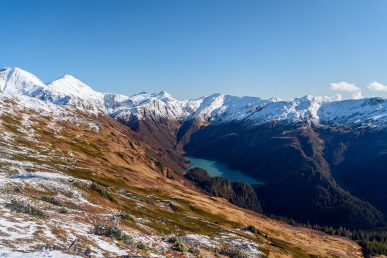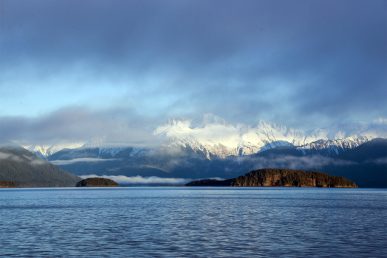What climate-driven changes await coastal temperate rainforest ecosystems?

Like the Great Lakes region, the coastal temperate rainforest of North America is a transboundary region covering parts of Canada and the U.S. and is extremely important for lateral transport of freshwater. The coastal marine environments are inherently linked with the land through the delivery of nutrients that drive ocean productivity.
“The amount of freshwater transported from the mountains to the nearshore ocean is at least as big as the Mississippi River every year, and it’s mostly exported in small steep watersheds,” said Gavin McNicol, assistant professor of earth and environmental sciences at the University of Illinois Chicago.
McNicol was part of an interdisciplinary research team with expertise in marine systems, water chemistry, glaciers, forest ecology, soil, and geology that sought to understand the ecological processes of coastal environments and what they might look like in our changing climate.
Their paper, published in the journal BioScience, assesses the land-to-ocean flow of carbon and nutrients in the northeast Pacific coastal temperate rainforest, or NPCTR, their influence on nearshore marine ecosystems, and how these connections are altered by climate change.
“In addition to our evaluation of how these connections may be altered by global climate change, we identify knowledge gaps in our understanding of the source, transport, and fate of terrestrial materials along this coastal margin,” said McNicol, a corresponding author on the paper.
The NPCTR covers more than 1,200 miles from the glacial valleys and marine fjords of southcentral Alaska to the redwood forests of northern California. It’s a hotspot for carbon storage and nutrient transport into coastal waters, but relatively few comprehensive studies have been conducted across the system as a whole.
With the NPCTR as the focal point, the researchers examined important above- and below-ground production and hydrological transport processes that control the land-to-ocean flow of materials and their influence on nearshore marine ecosystems.
Five priority research themes, within the context of climate change, in the region emerged as relevant for understanding coastal ecosystem links more broadly, the researchers report.
- Will the terrestrial ecosystems of the NPCTR become a source or sink of carbon under a changing climate?
- How will predicted climate changes influence the land-to-ocean movement of freshwater and materials?
- What regime shifts and non-linearities will dominate NPCTR ecosystem dynamics under continued climate change?
- How will key linkages among NPCTR ecosystem components strengthen or weaken with continued climate change?
- What is the relative importance of terrestrially derived materials in regulating marine ecosystem processes in the NPCTR and how will marine ecosystems respond to altered land-to-ocean materials fluxes?

McNicol said that previous studies that have been conducted in the region typically focus on distinct ecosystems rather than the tightly linked land-to-marine ecosystem.
“Although coastal temperate rainforests make up a relatively small portion of the land cover on the planet, they sequester more carbon per unit area than any other forested ecosystem. It’s important to understand the processes at play that sequester and move carbon out of these ecosystems because of their disproportionate impact on global carbon cycling,” said project leader Allison Bidlack of the National Marine Fisheries Service’s Alaska Fisheries Science Center and former director of the University of Alaska Southeast’s Alaska Coastal Rainforest Center.
The paper is a byproduct of a workshop organized by the Coastal Rainforest Margins Research Network, which is supported by the National Science Foundation, the University of Washington Freshwater Initiative, the Hakai Institute and the University of Alaska Southeast.
Co-authors of the study are Jason Fellman formerly of the Alaska Coastal Rainforest Center at the University of Alaska Southeast; Sarah Bisbing of the University of Nevada–Reno; Brian Buma of the University of Colorado at Denver; Heida Diefenderfer of the Pacific Northwest National Laboratory, Marine Sciences Laboratory and the University of Washington; William Floyd of the British Columbia Ministry of Forests, Lands, and Natural Resource Operations and with Vancouver Island University; Ian Giesbrecht of the Hakai Institute and Simon Fraser University; Amritpal Lally of Vancouver Island University; Ken Lertzman of Simon Fraser University; Steven S. Perakis of the U.S. Geological Survey, Forest and Rangeland Ecosystem Science Center; David Butman of the University of Washington; David D’Amore of the U.S. Forest Service Pacific Northwest Research Station; Sean Fleming of the National Water and Climate Center of the U.S. Department of Agriculture Natural Resources Conservation Service; Eran Hood of the University of Alaska Southeast; Brian P. V. Hunt of the University of British Columbia and the Hakai Institute; Peter Kiffney of the National Oceanic and Atmospheric Administration, National Marine Fisheries Service, Northwest Fisheries Science Center, Watershed Program; Brian Menounos of the University of Northern British Columbia; and Suzanne Tank of the University of Alberta in Edmonton.
